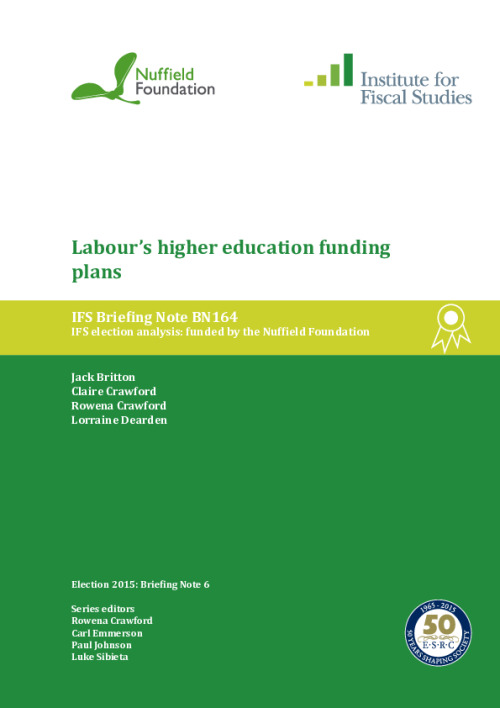This briefing note looks at the implications of Labour's proposals for higher education funding plans.
- On 27 February 2015, Labour announced its much-anticipated policy to reduce the undergraduate tuition fee cap to £6,000 per year for students in England. Alongside this change, it announced an increase in the interest rate charged on loans after graduation amongst high-income graduates, as well as a rise in average maintenance grants. University funding would be held constant under its proposal, with additional teaching grants distributed to universities to offset the lower fee income that they would receive.
- Mid- to high-income graduates are the primary beneficiaries of this reform, with the very highest earners benefiting the most, despite the rise in interest rates that they would face. This is because high-earning graduates are the most likely to repay their loan in full under the current system; hence, they experience the largest reduction in repayments as a result of the lower fee cap (which the higher interest rate does not offset). Most lower-earning graduates will be unaffected.
- The introduction of the £9,000 per year tuition fee cap in 2012 appears to have had little or no effect on applications to, or participation in, higher education (HE) amongst full-time students. For this group, it is therefore unlikely that a reduction in the cap to £6,000 will boost enrolment. On the other hand, there have been large reductions in part-time enrolment. It is possible that the cut in the cap could help those numbers recover.
- Taken in isolation, this policy would slightly weaken the public finances. Debt will be permanently higher in the long run as a result of replacing fee loans with teaching grants, since some of the loans would have been repaid while grants are not.
- Based on current estimates of future graduate loan repayments, we estimate that the changes made to the HE finance system would result in an increase in the long-run taxpayer contribution to higher education of around £1,000 per student per year (£3,000 per student per degree) in today’s money. For a cohort of 350,000 students, this is an increase in taxpayer support for higher education (resulting in an increase in public debt in the long run) of around £1 billion in today’s money. The long-run cost of this policy relative to the current system, however, depends crucially on future graduate loan repayments, which are highly uncertain.
- In the absence of any other policy changes, Labour would have to find around £3.2 billion from net tax rises or spending cuts to pay for the full difference between current fees and the new £6,000 per year cap (which we assume all universities would charge) if borrowing is to be left unchanged in the short run.
- The Labour party proposes to avoid these effects by implementing a permanent tax increase through restricting tax relief available on pension contributions. This would more than offset the long-term increase in government debt created by the HE policy changes.











